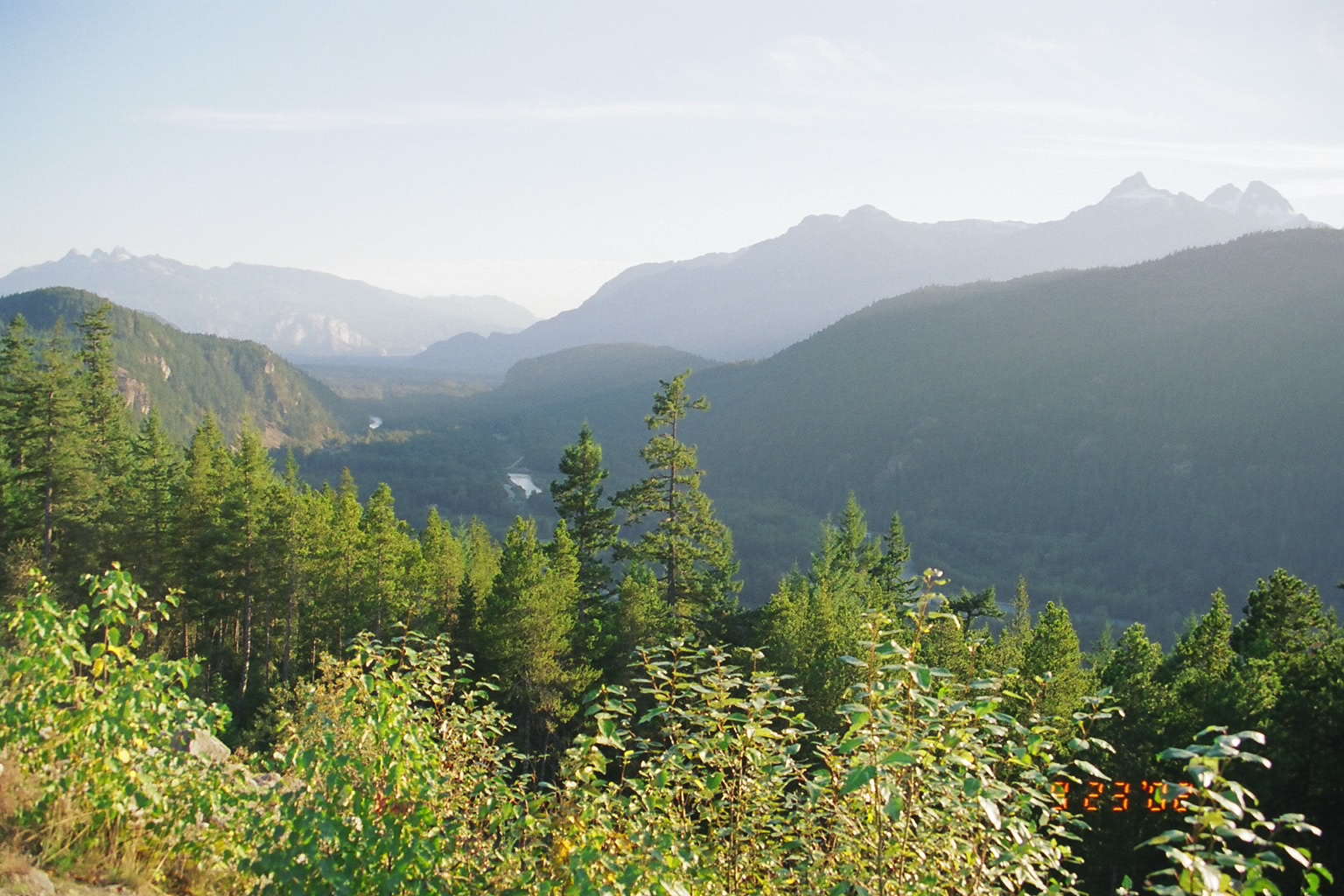|
Forger Peak
Forger Peak is a mountain summit in British Columbia, Canada. Description Forger Peak is located southeast of Whistler in Garibaldi Provincial Park. It is part of the McBride Range which is a subrange of the Coast Mountains. Precipitation runoff and glacial meltwater from the mountain's slopes drains north to the Cheakamus River and south to the Pitt River. Forger Peak is more notable for its steep rise above local terrain than for its absolute elevation as topographic relief is significant with the west slope rising 1,223 metres (4,012 ft) in . The mountain is named in association with the officially named Forger Glacier which is a descriptive name for the forging action of the glacier in shaping the local terrain. The first ascent of the summit was made in 1972 by John Clarke and B. Samson. Climate Based on the Köppen climate classification, Forger Peak is located in the marine west coast climate zone of western North America. Most weather fronts originate in th ... [...More Info...] [...Related Items...] OR: [Wikipedia] [Google] [Baidu] |
Mount Sir Richard
Mount Sir Richard is a glaciated summit in British Columbia, Canada. Description Mount Sir Richard is located in the McBride Range of the Coast Mountains, and southeast of Whistler in Garibaldi Provincial Park. It is the highest point of the McBride Range and seventh-highest peak within the park. Precipitation runoff and glacial meltwater from this mountain's south and east slopes drains to the Lillooet River via Tuwasus Creek, whereas the north and west slopes drain into headwaters of the Cheakamus River. Mount Sir Richard is more notable for its steep rise above local terrain than for its absolute elevation as topographic relief is significant with the summit rising 1,880 metres (6,168 ft) above Tuwasus Creek in less than and 1,380 metres (4,527 ft) above Cheakamus River in . History The mountain's name honors Sir Richard McBride (1870–1917). The toponym was officially adopted September 2, 1930, by the Geographical Names Board of Canada. In 1903, at ... [...More Info...] [...Related Items...] OR: [Wikipedia] [Google] [Baidu] |
Forging
Forging is a manufacturing process involving the shaping of metal using localized compression (physics), compressive forces. The blows are delivered with a hammer (often a power hammer) or a die (manufacturing), die. Forging is often classified according to the temperature at which it is performed: cold forging (a type of cold working), warm forging, or hot forging (a type of hot working). For the latter two, the metal is heated, usually in a forge. Forged parts can range in weight from less than a kilogram to hundreds of metric tons.Degarmo, p. 389 Forging has been done by metalsmith, smiths for millennia; the traditional products were kitchenware, household hardware, hardware, hand tools, edged weapons, cymbals, and jewellery. Since the Industrial Revolution, forged parts are widely used in mechanism (engineering), mechanisms and machines wherever a component requires high strength of materials, strength; such forgings usually require further processing (such as machining) ... [...More Info...] [...Related Items...] OR: [Wikipedia] [Google] [Baidu] |
Two-thousanders Of British Columbia
Two-thousanders are mountains that have a height of at least 2,000 metres above sea level, but less than 3,000 metres. The term is used in Alpine circles, especially in Europe (e.g. German: ''Zweitausender''). The two photographs show two typical two-thousanders in the Alps that illustrate different types of mountain. The Säuling (top) is a prominent, individual peak, whereas the Schneeberg (bottom) is an elongated limestone massif. In ranges like the Allgäu Alps, the Gesäuse or the Styrian-Lower Austrian Limestone Alps the mountain tour descriptions for mountaineers or hikers commonly include the two-thousanders, especially in areas where only a few summits exceed this level. Examples from these regions of the Eastern Alps are: * the striking Nebelhorn (2,224 m) near Oberstdorf or the Säuling (2,047 m) near Neuschwanstein, * the Admonter Reichenstein (2,251 m), Eisenerzer Reichenstein (2,165 m), Großer Pyhrgas (2,244 m) or Hochtor (2,3 ... [...More Info...] [...Related Items...] OR: [Wikipedia] [Google] [Baidu] |
Mount Davidson (British Columbia)
Mount Davidson is a mountain summit located in the Garibaldi Ranges of the Coast Mountains, in Garibaldi Provincial Park of southwestern British Columbia, Canada. Visible from the Whistler Blackcomb ski area, it is situated south of Whistler, and its nearest higher peak is Castle Towers Mountain, to the west. The Cheakamus Glacier lies between these two summits, and precipitation runoff from the peak and meltwater from the glacier drains into tributaries of the Cheakamus River. The first ascent of the mountain was made in 1929 by Neal M. Carter and Emmy Milledge. The mountain is named after Professor John Davidson (1878 – 1970), who contributed a large amount of botanical knowledge about Garibaldi Park. The mountain's toponym was officially adopted on September 2, 1930, by the Geographical Names Board of Canada. __NOTOC__ Climate Based on the Köppen climate classification, Mount Davidson is located in the marine west coast climate zone of western North America. Most weat ... [...More Info...] [...Related Items...] OR: [Wikipedia] [Google] [Baidu] |
Mount Pitt
Mount Pitt is a summit in British Columbia, Canada. Description Mount Pitt is located in the McBride Range of the Coast Mountains, and southeast of Whistler in Garibaldi Provincial Park. The remote peak is the fourth-highest point of the McBride Range and 37th-highest peak within the park. Precipitation runoff and glacial meltwater from this mountain's north and east slopes drains to the Lillooet River via Tuwasus Creek, whereas the south and west slopes drain to the Pitt River. Mount Pitt is more notable for its steep rise above local terrain than for its absolute elevation as topographic relief is significant with the summit rising 1,487 metres (4,880 ft) above Tuwasus Creek in and the west aspect rises approximately 1,200 metres (3,937 ft) in . This mountain is located near the head of Pitt River, which is named after William Pitt the Younger (1759–1806), and the mountain's toponym was officially adopted August 14, 1952, by the Geographical Names Boar ... [...More Info...] [...Related Items...] OR: [Wikipedia] [Google] [Baidu] |
Cheakamus Mountain
Cheakamus Mountain is a glacier-clad peak located in the Garibaldi Ranges of the Coast Mountains, in Garibaldi Provincial Park of southwestern British Columbia, Canada. It is the fourth-highest peak of the Fitzsimmons Range, which is a subset of the Garibaldi Ranges. It is situated southeast of Whistler, and its nearest higher peak is Mount Benvolio, to the northwest. The Diavolo Glacier spreads out below the north aspect of the peak, and precipitation runoff from the peak with meltwater from the glacier drains into tributaries of the Cheakamus River. The peak was named in association with the river, which in turn is anglicized from ''Tseearkamisht'', a Squamish word meaning ''"people who use the cedar rope fishing net"''. The mountain's name was officially adopted on September 2, 1930, by the Geographical Names Board of Canada. The first ascent of the mountain was made in 1950 by Roy Hooley, Jimmy Kilborn, and Ian Kirk. Climate Based on the Köppen climate classificati ... [...More Info...] [...Related Items...] OR: [Wikipedia] [Google] [Baidu] |
Geology Of British Columbia
The geology of British Columbia is a function of its location on the leading edge of the North American continent. The mountainous physiography and the diversity of the different types and ages of rock hint at the complex geology, which is still undergoing revision despite a century of exploration and mapping. The province's most prominent geological features are its mountain ranges, including the North American Cordillera which stretches from Southern Mexico to Alaska. Terrane theory Terrane theory was first proposed by Jim Monger of the Geological Survey of Canada and Charlie Rouse in 1971 as an explanation for a set of fusulinid fossils that were found in central British Columbia. Rather than suggest that facies changes or seaways were behind this (which were common explanations at the time), the two geologists proposed that the fossils in question had been part of an assemblage of rocks that had migrated across the Pacific Ocean to their present location. This theor ... [...More Info...] [...Related Items...] OR: [Wikipedia] [Google] [Baidu] |
Geography Of British Columbia
British Columbia is the westernmost province of Canada, bordered by the Pacific Ocean. With an area of it is Canada's third-largest province. The province is almost four times the size of the United Kingdom and larger than every United States state except Alaska. It is bounded on the northwest by the U.S. state of Alaska, directly north by Yukon and the Northwest Territories, on the east by Alberta, and on the south by the U.S. states of Washington, Idaho, and Montana. Formerly part of the British Empire, the southern border of British Columbia was established by the 1846 Oregon Treaty. The province is dominated by mountain ranges, among them the Canadian Rockies but dominantly the Coast Mountains, Cassiar Mountains, and the Columbia Mountains. Most of the population is concentrated on the Pacific coast, notably in the area of Vancouver, located on the southwestern tip of the mainland, which is known as the Lower Mainland. It is the most mountainous province of Canada. St ... [...More Info...] [...Related Items...] OR: [Wikipedia] [Google] [Baidu] |
Orographic Lift
Orographic lift occurs when an air mass is forced from a low elevation to a higher elevation as it moves over rising terrain. As the air mass gains altitude it quickly cools down adiabatically, which can raise the relative humidity to 100% and create clouds and, under the right conditions, precipitation. Orographic lifting can have a number of effects, including precipitation, rain shadowing, leeward winds, and associated clouds. Precipitation Precipitation induced by orographic lift occurs in many places throughout the world. Examples include: * The Mogollon Rim in central Arizona * The western slope of the Sierra Nevada range in California. * The western slope of the Wasatch Range in Utah. Specifically the Little and Big Cottonwood Canyons. * The mountains near Baja California North – specifically La Bocana to Laguna Hanson. * The windward slopes of Khasi and Jayantia Hills (see Mawsynram) in the state of Meghalaya in India. * The Western Highlands of Yemen, which rece ... [...More Info...] [...Related Items...] OR: [Wikipedia] [Google] [Baidu] |
Weather Front
A weather front is a boundary separating air masses for which several characteristics differ, such as air density, wind, temperature, and humidity. Disturbed and unstable weather due to these differences often arises along the boundary. For instance, cold fronts can bring bands of thunderstorms and cumulonimbus precipitation or be preceded by squall lines, while warm fronts are usually preceded by stratiform precipitation and fog. In summer, subtler humidity gradients known as dry lines can trigger severe weather. Some fronts produce no precipitation and little cloudiness, although there is invariably a wind shift. Cold fronts generally move from west to east, whereas warm fronts move poleward, although any direction is possible. Occluded fronts are a hybrid merge of the two, and stationary fronts are stalled in their motion. Cold fronts and cold occlusions move faster than warm fronts and warm occlusions because the dense air behind them can lift as well as push the warme ... [...More Info...] [...Related Items...] OR: [Wikipedia] [Google] [Baidu] |
Marine West Coast
An oceanic climate, also known as a marine climate or maritime climate, is the temperate climate sub-type in Köppen classification represented as ''Cfb'', typical of west coasts in higher middle latitudes of continents, generally featuring cool to warm summers and cool to mild winters (for their latitude), with a relatively narrow annual temperature range and few extremes of temperature. Oceanic climates can be found in both hemispheres generally between 40 and 60 degrees latitude, with subpolar versions extending to 70 degrees latitude in some coastal areas. Other varieties of climates usually classified together with these include subtropical highland climates, represented as ''Cwb'' or ''Cfb'', and subpolar oceanic or cold subtropical highland climates, represented as ''Cfc'' or ''Cwc''. Subtropical highland climates occur in some mountainous parts of the subtropics or tropics, some of which have monsoon influence, while their cold variants and subpolar oceanic climates occu ... [...More Info...] [...Related Items...] OR: [Wikipedia] [Google] [Baidu] |
Köppen Climate Classification
The Köppen climate classification divides Earth climates into five main climate groups, with each group being divided based on patterns of seasonal precipitation and temperature. The five main groups are ''A'' (tropical), ''B'' (arid), ''C'' (temperate), ''D'' (continental), and ''E'' (polar). Each group and subgroup is represented by a letter. All climates are assigned a main group (the first letter). All climates except for those in the ''E'' group are assigned a seasonal precipitation subgroup (the second letter). For example, ''Af'' indicates a tropical rainforest climate. The system assigns a temperature subgroup for all groups other than those in the ''A'' group, indicated by the third letter for climates in ''B'', ''C'', ''D'', and the second letter for climates in ''E''. Other examples include: ''Cfb'' indicating an oceanic climate with warm summers as indicated by the ending ''b.'', while ''Dwb'' indicates a semi-Monsoon continental climate, monsoonal continental climate ... [...More Info...] [...Related Items...] OR: [Wikipedia] [Google] [Baidu] |








